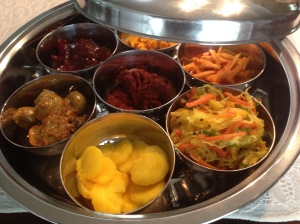
This takes me back to Tanzania for sure, the beautiful, colourful athana ni sahani. For my friends who don’t speak Swahili, sahani means platter, tray, or plate. Athana is a gujarati word for pickles and condiments and so in this post I want to share some recipes and some tidbits about the athana ni sahani.
In East Africa in most gujarati households the athana ni sahani graces most dining tables at most meal times be it snack, lunch, dinner or indeed breakfast. The platter consists of an array of condiments and pickles in tiny little bowls which bear equally tiny spoons whose purpose seems almost like an education in the athana etiquette. The tiny bowls and spoons tell you that your are not meant to pile the athana onto your plate, but to use a little of each condiment to enhance your experience of the meal which you are about to partake.
At the Vithlani house in Mwanza where my in-laws resided, the athana ni sahani was almost integral to every meal. My motabhai,(brother in law and Manu’s older Brother) and my MIL were very partial to the athanas. My MIL was in charge of purchasing seasonal fruits such as mangoes and pickling them. In fact mangoes, karamdas, gunda, were all purchased in huge quantities and preserved in ceramic jars to keep the pickles kool and well preserved for the year. My motabhai was particularly fond of the athanas and the platter at their home would consists of items like pickled gunda, gor keri, katki keri, keri no chundo, garmar, rai marcha etc. Also and equally important was the sambharo that was made every single day. Mostly this was made with cabbage and carrots but occasionally my sister in law made potato sambharo or with gunda when in season. Each time I visited Mwanza and was on kitchen duty, I recall my mom in law asking me to prepare the sambharo. She used to say, I had mastered the art of finely shredding the cabbage and carrots and that it enhanced the flavour. One of the things I recall vividly about my motabhai is that he used to say chai bagde to sawar bagde , dal bagde to divas bagde, athanu badge to to varash badge and baidi bagde to zindagi bagde….to translate roughly ‘ if the daily mealtime dal is not cooked well, the meal is ruined, if the athana is not made well, the entire year is ruined and if the wife is not right for you, then your life is ruined.
Everyone in the Vithlani household loves their athanas from the elders to the kids. My nieces and nephews learnt to savour these from a very young age. Funny how the pattern was set : sambharo with cold rotli, chundo with puri, gor keri or lasan ni chutney with thepla or vada. Almost all of my nieces and nephews eat their puri/thepla with these athanas and the pattern continues in our Charleston home too. Traditionally, the matriarch of the household would make the pickles but here in Charleston, I have the honours and I must say, I quite enjoy the process. The beautiful fragrance of raw mango, the pungent aroma of the mustard seeds as they hit the hot oils and the heady scent of turmeric, chilli powder, ground mustard seeds, crushed coriander seeds take me into a different world altogether, almost like I was back in Zanzibar where the smell of cloves and spices lingers about in the atmosphere.

I also try and make sambharo whenever I can as Manu and I both enjoy this. Equally important in our house is pickled ginger. rai marcha and of course the all time guju favourite, the gor keri.
As I have already shared the recipe for gor keri and rai marcha in my previous posts, I thought I would share here, the recipe for cabbage and carrot sambharo, a mild simple stir fried condiment that your can enjoy with your rotlis.















